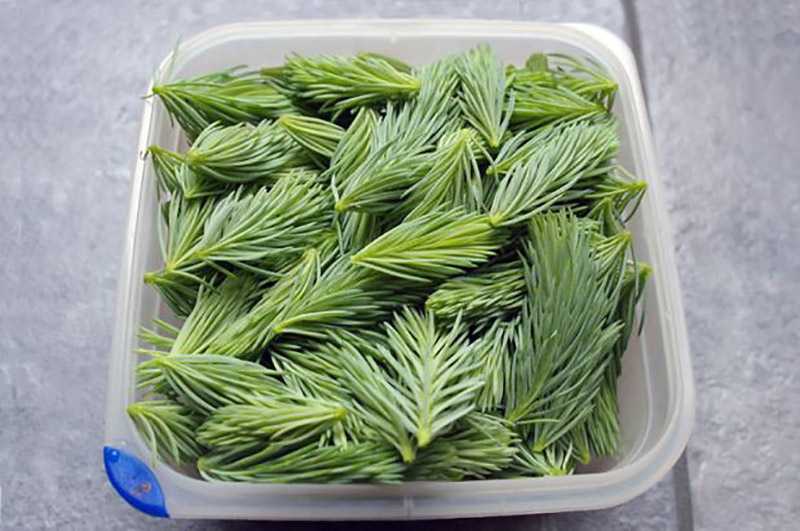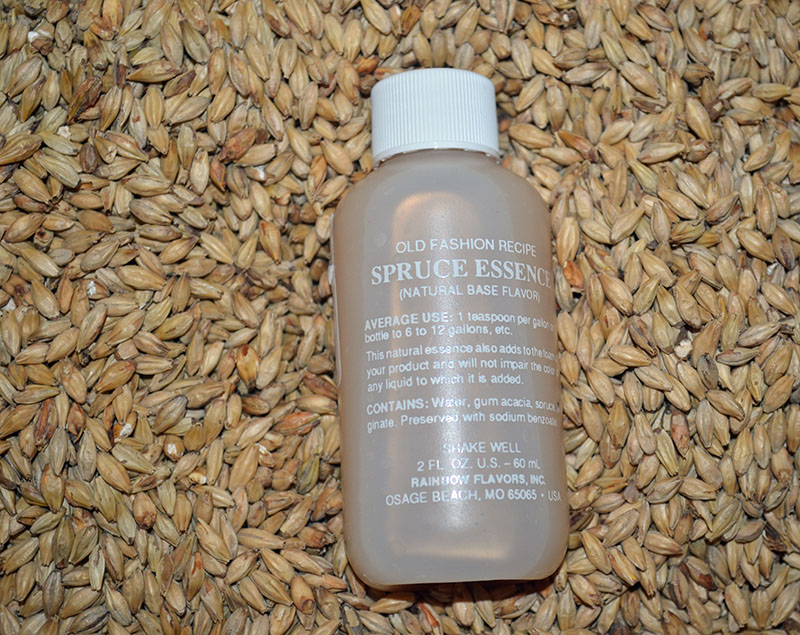Joe Lindsey
New Member
- Joined
- Apr 15, 2016
- Messages
- 1
- Reaction score
- 0
Thanks to El Nino and the mild winter, Spring is just a few drinks away. With Spring comes new growth, and with new growth comes new brewing ingredients. So grab your axe, let’s add some legitimacy to that lumberjack beard you’ve been sporting and let’s make a spruce beer!
Ok, so maybe the axe isn’t exactly necessary. The new growth tips from spruce trees are really what we’re after, and can be easily be picked by hand. But if you’re picking spruce in a public place or your neighbor's yard, at least wear a plaid flannel shirt.
 Any part of the branch can be used but tips pack the most punch
Any part of the branch can be used but tips pack the most punch
A tremendous source of vitamin C, spruce had long been used to ward off scurvy in our pirate and non-pirate forefathers. And, as with most things, the inventive ones found ways to make beer with it. The molasses based spruce beer recipes of Benjamin Franklin and Captain Cook have been recreated by several commercial breweries and home brewers alike. It can be found with a quick internet search. For those looking for an extreme, or at least different brew day, this is a good place to start.
If scurvy still scares you, then sell your home brew equipment and invest in oranges and lemons (as they are still better providers of Vitamin C). Luckily, most of us can simply focus on using spruce to flavor our beer, and decorate for Christmas. Just like hops, spruce can bring citrus, floral, and of course, pine flavors to your brew. Others have noted cola-like flavors. It also has bittering capabilities, but fresh spruce adds lots of astringency when boiled for long periods of time, so it is best used toward the end of the boil for flavoring and aroma.
Since spruce flavors mirror that of hops, it can be used alongside or as a substitute for them in your recipe. Cascade and Centennial are popular choices in spruce beer recipes.
 Tips are easier to spot by their softer feel and brighter color.
Tips are easier to spot by their softer feel and brighter color.
When foraging for spruce tips, the first thing you need to do is drink a beer. Then you need to find a spruce tree. Spruce is an evergreen conifer that grows in colder climates and is abundant in the northern U.S. and Canada, but can found further south in the central U.S. especially at higher elevations. Spruce needles grow directly and individually from the branch, unlike many pine trees which grow in clusters. Remove the needles and feel the branch. Spruce branches are rough whereas firs are smoother.
Any part of the tree can be used for brewing, but the tips offer the freshest flavors and are easiest to use. The new growth is abundant in the spring, so be on the lookout in the coming weeks. The new growth that comes out is easy to identify, as it is brighter and softer than the rest of the tree. Be respectful of the tree and don’t over pick any one branch. Two to eight ounces of tips are often used in a five gallon batch. Keep in mind that the smaller tips have a milder flavor. They can be stored in the freezer, but fresh is best.
Spruce can be successfully merged with styles ranging from pilsners to imperial stouts, and can either compliment the flavor, or dominate the beer. Typically, the higher your OG, the more spruce you should use to poke through the other flavors. Most recipes call for a 15-minute boil when using tips.
 If worst comes to worst, you can always find some high quality spruce essence to use.
If worst comes to worst, you can always find some high quality spruce essence to use.
If you don’t have a beard, or fresh tips are out of season, then spruce essence is a fantastic option. Good essence will be made from real spruce and other resin products. Like most flavorings, it can incrementally be added at bottling or kegging to your taste. Be careful though, because this stuff is strong. Try adding ½ a teaspoon at a time until you find the flavor you’re looking for.
So if you’re trying to find some zing for that spring recipe that’s been on your brain these last few winter months, or want to add that extra Christmas punch to your winter beer, then the power of spruce may just be the source for your next brew inspiration.

Ok, so maybe the axe isn’t exactly necessary. The new growth tips from spruce trees are really what we’re after, and can be easily be picked by hand. But if you’re picking spruce in a public place or your neighbor's yard, at least wear a plaid flannel shirt.
 Any part of the branch can be used but tips pack the most punch
Any part of the branch can be used but tips pack the most punchA tremendous source of vitamin C, spruce had long been used to ward off scurvy in our pirate and non-pirate forefathers. And, as with most things, the inventive ones found ways to make beer with it. The molasses based spruce beer recipes of Benjamin Franklin and Captain Cook have been recreated by several commercial breweries and home brewers alike. It can be found with a quick internet search. For those looking for an extreme, or at least different brew day, this is a good place to start.
If scurvy still scares you, then sell your home brew equipment and invest in oranges and lemons (as they are still better providers of Vitamin C). Luckily, most of us can simply focus on using spruce to flavor our beer, and decorate for Christmas. Just like hops, spruce can bring citrus, floral, and of course, pine flavors to your brew. Others have noted cola-like flavors. It also has bittering capabilities, but fresh spruce adds lots of astringency when boiled for long periods of time, so it is best used toward the end of the boil for flavoring and aroma.
How to Use Spruce in Your Beer
Since spruce flavors mirror that of hops, it can be used alongside or as a substitute for them in your recipe. Cascade and Centennial are popular choices in spruce beer recipes.
 Tips are easier to spot by their softer feel and brighter color.
Tips are easier to spot by their softer feel and brighter color.When foraging for spruce tips, the first thing you need to do is drink a beer. Then you need to find a spruce tree. Spruce is an evergreen conifer that grows in colder climates and is abundant in the northern U.S. and Canada, but can found further south in the central U.S. especially at higher elevations. Spruce needles grow directly and individually from the branch, unlike many pine trees which grow in clusters. Remove the needles and feel the branch. Spruce branches are rough whereas firs are smoother.
Any part of the tree can be used for brewing, but the tips offer the freshest flavors and are easiest to use. The new growth is abundant in the spring, so be on the lookout in the coming weeks. The new growth that comes out is easy to identify, as it is brighter and softer than the rest of the tree. Be respectful of the tree and don’t over pick any one branch. Two to eight ounces of tips are often used in a five gallon batch. Keep in mind that the smaller tips have a milder flavor. They can be stored in the freezer, but fresh is best.
Spruce can be successfully merged with styles ranging from pilsners to imperial stouts, and can either compliment the flavor, or dominate the beer. Typically, the higher your OG, the more spruce you should use to poke through the other flavors. Most recipes call for a 15-minute boil when using tips.
Spruce Tip Alternatives
 If worst comes to worst, you can always find some high quality spruce essence to use.
If worst comes to worst, you can always find some high quality spruce essence to use.If you don’t have a beard, or fresh tips are out of season, then spruce essence is a fantastic option. Good essence will be made from real spruce and other resin products. Like most flavorings, it can incrementally be added at bottling or kegging to your taste. Be careful though, because this stuff is strong. Try adding ½ a teaspoon at a time until you find the flavor you’re looking for.
So if you’re trying to find some zing for that spring recipe that’s been on your brain these last few winter months, or want to add that extra Christmas punch to your winter beer, then the power of spruce may just be the source for your next brew inspiration.















![Craft A Brew - Safale BE-256 Yeast - Fermentis - Belgian Ale Dry Yeast - For Belgian & Strong Ales - Ingredients for Home Brewing - Beer Making Supplies - [3 Pack]](https://m.media-amazon.com/images/I/51bcKEwQmWL._SL500_.jpg)










































